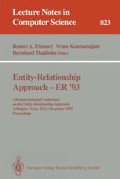Abstract
In the paper we look for the solution of two problems: the unification of various paradigms of semantic database models inside one logical framework, and schema mismatch problems arising during merging process of two schemata from different models. As an approach we use SEL-logic, which captures database data level and metalevel (schema) information in such a way as to permit reasoning at both levels. Both levels are expressed as first-order logic formalisms.
Preview
Unable to display preview. Download preview PDF.
References
S. Abiteboul and R Hull. IFO: A formal semantic database model. ACM TODS, 12(4), (1987).
Kim B. Bruce, Peter Wegner, An algebraic Model of Subtype and Inheritance”, in: Advances in Database Programming Languages, ACM Press, (1990).
P. Chen. The entity-relationship model — toward a unified view of data. ACM TODS, 1(1) 9–36 (1976).
W. Chen, declarative specification and evaluation of database updates, Proc. 2nd Int'l Conf. DOOD'91, 1991.
J. Chudziak, H. Rybinski, and J. Vorbach. On Mapping Semantic Data Model Schemata into First_Order Logic, ICS Research Report Warsaw University of Technology, 13/93.
J. Chudziak, J. Vorbach, SDM-CASE: A Prototype of Semantic Database Design and Analyze System, in preparation.
T.Halpin, A Fact Oriented Approach to Schema Transformation, MFDBS'91, 342–356 (1991).
R. Hull and Ch.K. Yap, The Format Model: A Theory of Database Organization, JACM 31(4), 518–537 (1984).
R. Hull and R. King. Semantic database modeling: survey, application, and research issues, ACM Comp. Surveys, 19 (3), (1988)
The problem of equivalence for Entity-Relationship Diagrams, IEEE Trans. on Software Engineering, 9(5), (1983).
W. Kent. The breakdown of the Information Model in MDBSs, ACM SIGMOD RECORD, 20(4), (1991).
M. Kifer and G Lausen. F-Logic: a higher-order language for reasoning about objects, inheritance, and scheme. Proc. of the 8th ACM-SIGMOD Int'l Conf. on Management of Data, 134–146 (1989).
W. Kim and J. Seo. Classifying schematic and data heterogreneity in multidatabase systems. Computer, 24(12), (1991).
R. Krishnamurthy, W. Litwin, and W. Kent. Language Features for Interoperability of Databases with Schematic Discrepancies. Proc. of the 10th ACM-SIGMOD Int'l Conf. on Management of Data, 40–49 (1991).
D. Maier. O-Logic: a logic for objects, Workshop on Foundations of Deductive Databases and Logic Programming, D.C., 1986
J. Peckham and F. Maryanski. Semantic data models. ACM Computing Surveys. 20(3), 153–189 (1988).
H. Rasiowa, R. Sikorski. The Mathematics of Metamathematics, Polish Scientific Publishers, Warsaw, (1963)
H. Rybinski. On first order logic databases, ACM TODS 12(3), 325–349 (1987).
H. Rybinski and J. Vorbach. A logic approach to equivalence among semantic data model schemata, ICS Research Report Warsaw University of Technology, 7/93
D. Shipman. The functional data model and the data language DAPLEX. ACM TODS 6(1), (1981).
A. Sheith and J. Larson. Federated database systems for managing distributed, heterogenous, and automous databases. ACM Computing Surveys, 22(3), 183–236 (1990).
D. Smith and J. Smith. Database abstractions: aggregation and generalization. ACM TODS 2(2), (1977).
J. Vorbach. A graph theoretic approach for deriving meta-level information from schemata, Proc. of GWS Conf. on Intelligent Systems (1992)
Proc.of the ER'93 Conference (1993).
Author information
Authors and Affiliations
Editor information
Rights and permissions
Copyright information
© 1994 Springer-Verlag Berlin Heidelberg
About this paper
Cite this paper
Chudziak, J.A., Rybinski, H., Vorbach, J. (1994). Towards a unifying logic formalism for semantic data models. In: Elmasri, R.A., Kouramajian, V., Thalheim, B. (eds) Entity-Relationship Approach — ER '93. ER 1993. Lecture Notes in Computer Science, vol 823. Springer, Berlin, Heidelberg. https://doi.org/10.1007/BFb0024390
Download citation
DOI: https://doi.org/10.1007/BFb0024390
Published:
Publisher Name: Springer, Berlin, Heidelberg
Print ISBN: 978-3-540-58217-5
Online ISBN: 978-3-540-48575-9
eBook Packages: Springer Book Archive

